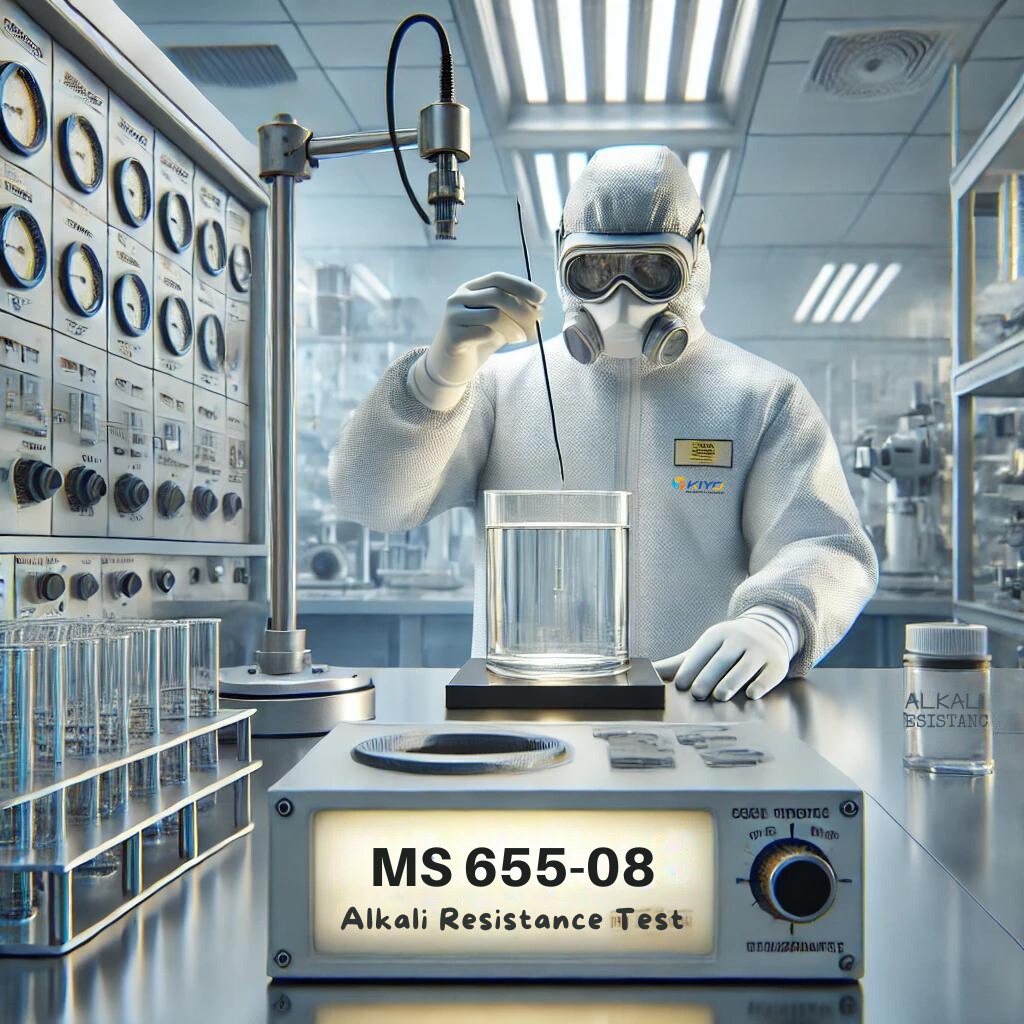Alkali Resistance Test As Per Standard MS 655-08
The Role of Alkali Resistance Testing in Material Durability: Insights into MS 655-08
Introduction
- In industries where materials are exposed to harsh environments, the ability to withstand chemical degradation is paramount. The Alkali Resistance Test, as defined by Standard MS 655-08, is a critical evaluation method used to ensure that materials can resist the damaging effects of alkaline substances. This blog explores the significance of this test, the procedures involved, and its impact on material performance and safety.

What is Alkali Resistance?
Alkali resistance refers to a material’s ability to resist the corrosive effects of alkaline substances. Alkaline environments, which are characterized by high pH levels, can cause significant damage to materials that are not resistant. This damage can manifest as discoloration, swelling, cracking, or even complete structural failure over time.
Materials commonly exposed to such environments include those used in construction, coatings, and certain industrial applications. Ensuring these materials can withstand alkaline exposure is essential for maintaining their integrity and functionality.
The Importance of MS 655-08
MS 655-08 is a Malaysian Standard that outlines the procedures for testing the alkali resistance of materials. This standard is essential because it provides a consistent and reliable method for evaluating how materials will perform when exposed to alkaline conditions. Compliance with MS 655-08 is crucial for manufacturers and engineers who need to ensure that their products meet safety, quality, and durability standards.
By adhering to this standard, companies can avoid costly material failures, ensure long-term durability, and meet regulatory requirements. The MS 655-08 standard is particularly relevant in industries where material failure could lead to significant safety hazards or financial losses.
The Testing Procedure
The Alkali Resistance Test according to MS 655-08 involves several critical steps designed to assess a material’s durability in alkaline conditions:
- Material Preparation: Samples of the material to be tested are prepared according to specific guidelines. This includes cutting the material into standardized sizes and shapes to ensure consistency in testing.
- Exposure to Alkaline Solution: The prepared samples are then immersed in an alkaline solution, typically a sodium hydroxide (NaOH) solution, for a specified period. The concentration of the solution and the duration of exposure are carefully controlled to replicate the conditions the material is likely to face in real-world applications.
- Observation and Analysis: After the exposure period, the samples are removed from the solution and analyzed for any signs of degradation. This analysis includes checking for physical changes such as discoloration, swelling, cracking, or other forms of deterioration.
- Documentation and Reporting: The results of the test are meticulously recorded, including details of any changes in the material’s appearance or properties. This documentation is critical for validating the material’s performance and for future reference in quality control processes.
Applications and Benefits of Alkali Resistance Testing
Alkali resistance testing is vital in several key industries:
- Construction: Materials such as concrete, cement, and other building components must resist alkaline conditions to prevent premature degradation, which could compromise structural integrity.
- Coatings and Paints: Protective coatings used on surfaces exposed to alkaline substances must maintain their integrity to ensure long-lasting protection.
- Plastics and Polymers: Many polymers used in industrial applications are exposed to alkaline environments. Testing these materials ensures they remain functional and durable over time.
The benefits of conducting alkali resistance testing according to MS 655-08 are clear:
- Enhanced Durability: Materials that pass the alkali resistance test are more likely to withstand the rigors of real-world use, leading to longer service life and reduced maintenance costs.
- Safety Assurance: Ensuring materials are resistant to alkali-induced degradation reduces the risk of failure in critical applications, enhancing overall safety.
- Regulatory Compliance: Adhering to MS 655-08 ensures that materials meet industry standards, which is essential for regulatory compliance and market acceptance.

Conclusion
- The Alkali Resistance Test, as outlined by MS 655-08, is a fundamental procedure for assessing the durability and reliability of materials in alkaline environments. By following this standard, manufacturers and engineers can ensure that their materials are fit for purpose, reducing the risk of failure and extending the life of their products. Understanding and implementing alkali resistance testing is not just about meeting regulatory requirements; it's about ensuring that the materials used in construction, industrial applications, and protective coatings are capable of withstanding the challenges posed by alkaline exposure. In doing so, companies can deliver products that are not only compliant but also reliable, durable, and safe for use in a wide range of environments.

